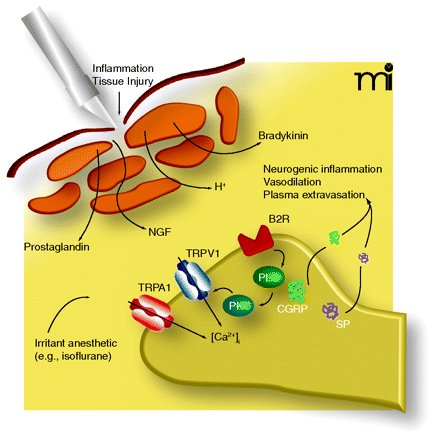
- Institution: Stanford Univ Med Ctr Lane Med Lib/Periodical Dept/Rm L109
- Sign In as Member / Individual
Anesthetic Activation of Nociceptors: Adding Insult to Injury?

Mechanisms of sensitization (simplified) in peripheral nociceptors after tissue injury and inflammation and proposed interaction of inhaled anesthetics. Tissue injury leads to activation of nociceptive nerve terminals, which will then trigger the release of the neuropeptides calcitonin-gene-related-peptide (CGRP) and substance P (SP). CGRP causes arteriolar vasodilatation and SP induces a vascular leak leading to plasma extravasation. Tissue injury will further lead to release of inflammatory mediators including cytokines, proteases, bradykinin (BK), nerve growth factor (NGF), histamine and 5-hydroxytryptamine (5-HT). Together, these factors act to increase the sensitivity of the nociceptor by different specific mechanisms. Some of these mechanisms converge and lead to activation of protein kinase C and to increase in intracellular calcium, an important second messenger molecule. Through activation of TRPA1 and sensitization of TRPV1, certain irritant general anesthetics can potentially augment this sensitization or may even lead to clinically relevant sensitization independent of injury. Together, these effects might contribute to postoperative pain and airway irritation. PLC, phospholipase C; NGF, nerve growth factor.


